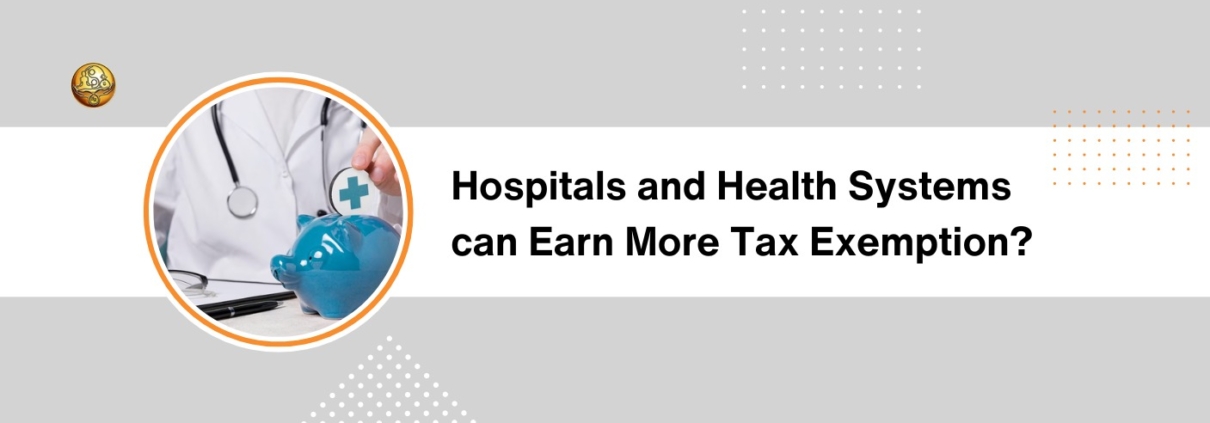Hospitals and health systems play a vital role in our communities, offering care and compassion during life’s most critical moments. Unlike other healthcare sectors, they respond to emergencies like heart attacks and accidents with open doors and immediate support. Ever wondered how they manage to offer so much to their communities?
You won’t believe the mind-blowing figures! In 2019 alone, they provided benefits worth a staggering $110 billion, and that’s just what the IRS counts. There’s so much more that goes uncounted, like medical research and subsidies to keep specialized units open.
Check Report- New EY Analysis: Tax-Exempt Hospitals’ Community Benefits Nine Times Greater Than Value of Federal Tax Exemption
In return for this privilege, these hospitals publicly disclose the extensive range of benefits and services they bring to their communities, including financial assistance for those facing hardships. These contributions are documented in annual reports filed with the IRS.
In this blog, we’ll explore how hospitals can earn and maintain tax exemptions while positively impacting the lives of people they serve.”
Read More – Retirement Planning for Doctors to Build a Financially Secure Future
Navigating Tax-Exempt Status for Health Care Organizations
So, as you already know how hospitals and health care organizations with tax-exempt status get some awesome benefits. This include like not paying corporate taxes on their income. Plus, they can also get exemptions from other taxes like sales and real estate.
But to keep that status, they need to report on their activities, like community benefits and charity care. It’s crucial to do this accurately, or they might face scrutiny later on. But hey, don’t worry, let’s break it down step by step!
1. Distinguishing Tax-Exempt Status
First off, tax-exempt health care organizations, which fall under the Internal Revenue Code section 501(c)(3), have to fill out Form 990. This form gives a clear picture of what they’ve been up to. Schedule H is a part of this form and requires data on financial assistance and community benefit programs. This includes things like charity care provided and the costs of treating Medicaid patients without compensation. This info helps set them apart from for-profit hospitals that offer the same medical services.
2. The Burden of Reporting
Some people see reporting as a burden for tax-exempt health care providers. They need to prove their worth and justify their tax-exempt status compared to for-profit hospitals. But don’t worry; we’ll figure this out together!
3. What Providers Should Do
Alright, here’s the deal for health care providers. It’s essential to accurately record and measure their community benefit efforts and charitable actions. Tax-exempt hospitals and health care systems must ensure that their reporting on Schedule H and to the media is complete and accurate. Show off all the good stuff they’ve been doing for their communities!
4. The Key to Maintaining Tax-Exempt Status
To keep that precious tax-exempt status, providers need to showcase their impact on the community. It’s not just about the data; it’s about the difference they’ve made. So, tell the world about all those community benefits and charitable efforts.
Okay, we’ve gone through the fundamentals of tax-exempt status for health care organizations. Let us now discuss about some controversy over the tax exempt hospitals.
Controversy over Tax-Exempt Hospitals
1. What’s the issue?
For the past 30 years, people have argued whether tax-exempt hospitals are meeting their community benefit obligations. Some say they’re not doing enough, especially when it comes to charity care. There are also concerns about their business investments, aggressive billing, and top executives’ pay. This has sparked government hearings and media attention.
Check News- Nonprofit hospitals under growing scrutiny over how they justify billions in tax breaks
2. Lack of Clarity and Conflicting Opinions
One problem is that there are no clear rules about what tax-exempt hospitals should be doing for the community. Some think hospitals should give back as a trade-off for tax breaks. Others believe tax exemption is for hospitals being charitable, even if it’s hard to measure.
3. The Data Dilemma
Studies have tried to figure out if tax-exempt hospitals are doing their part, but it’s tricky. People can’t agree on what counts as a community benefit, and the data is sometimes not enough.
One study found that tax-exempt hospitals spent about 7.5% of their expenses on community benefits, like charity care and health services, but it varies a lot between hospitals and states.
4. How Tax-Exempt Hospitals Compare
Researchers have also compared tax-exempt hospitals with regular ones. Tax-exempt hospitals do spend a bit more on charity care, but the difference gets smaller when you include bad debt. Bad debt happens when uninsured patients can’t pay and don’t meet charity care rules. This makes it hard to tell the real difference.
Are They Pulling Their Weight? People wonder if tax-exempt hospitals are doing enough compared to the tax benefits they get. Some studies say yes, more tax benefits mean more charity spending. But most studies show that their community benefits fall short compared to how much they save in taxes. It depends on how you look at it!
Read More –Maximizing Tax Savings: 14 Essential Tax Deductions for Doctors
Estimated Value of Tax Exemption for Nonprofit Hospitals
People are wondering if nonprofit hospitals, which make up 58% of community hospitals, deserve to be tax-exempt. Recent reports show some of these hospitals aggressively pursuing unpaid medical bills, even from eligible patients.
Research also reveals that nonprofit hospitals spend a similar or smaller portion of their budget on charity care compared to for-profit hospitals. To address these concerns, several policy ideas aim to align the community benefits provided by nonprofit hospitals with their tax exemption value.
1. Estimating the Value of Tax Exemption
To understand the value of tax exemption for nonprofit hospitals, researchers analyzed hospital cost reports, IRS filings, and AHA survey data. Tax exemption includes benefits like no federal and state corporate income taxes, no state and local sales taxes, no local property taxes, and potential increases in charitable contributions and lower bond interest rates due to tax-exempt status.
2. The Value of Tax Exemption: Results
The estimated value of tax exemption for nonprofit hospitals in 2020 was around $28 billion, accounting for 44% of their net income (revenues minus expenses). This value is comparable to the total Medicare and Medicaid disproportionate share hospital (DSH) payments, which help hospitals care for low-income patients and cover charity care and uncompensated care costs.
Read More – Financial Tax Planning Tips for Medical Professionals
3. Federal Tax-Exempt Status
Around half of the total tax exemption value ($14.4 billion) comes from not paying federal corporate income taxes ($10.3 billion). Individuals also tend to contribute more to tax-exempt hospitals due to tax deductions ($2.5 billion), and hospitals can issue bonds at lower interest rates due to tax exemption ($1.6 billion).
4. State and Local Tax-Exempt Status
The other half of the total tax exemption value ($13.7 billion) comes from not paying state or local sales taxes ($5.7 billion), local property taxes ($5.0 billion), and state corporate income taxes ($3.0 billion).
5. Tax Exemption Value vs. Charity Care Costs
In 2020, the estimated tax exemption value exceeded total charity care costs ($16 billion) among nonprofit hospitals. Charity care provides free or discounted services to eligible patients who can’t afford medical expenses. However, it’s just one part of the community benefits reported by hospitals.
Read More – Tax Reduction for Doctors in 2023: Maximize Deductions, Minimize Liability
6. Growth in Tax Exemption Value
The value of tax exemption increased from $19 billion in 2011 to $28 billion in 2020, a 45% rise. Although there was a $5.8 billion decrease in 2018 due to changes in federal corporate income tax rates, the value steadily increased over time.
The rise in 2020 was mainly due to increased net income for hospitals, including government relief and potentially higher investment income.
7. Reasons for Growth in Tax Exemption Value
The growth in tax exemption value over time can be attributed to increased net income before the pandemic, rising property values, supply expenses, and charitable contributions, each of which carries tax implications if hospitals lost their tax-exempt status. Even excluding the pandemic’s financial boost in 2020, nonprofit hospitals saw substantial net income growth in preceding years.
Conclusion
In conclusion, tax-exempt hospitals and health systems play a crucial role in our communities. They are providing benefits worth billions of dollars each year. To maintain status, they must accurately report their community benefits and charitable efforts. However, controversy surrounds whether they are meeting their obligations, with differing opinions and data challenges. Ultimately, striking a balance between both remains an ongoing challenge.
Frequently Asked Questions (FAQs):
Ques. What is FreeTaxUSA?
Ans. FreeTaxUSA is an online tax preparation service that helps individuals and businesses file their taxes quickly and affordably.
Ques. What is a tax exemption form?
Ans. A tax exemption form is a document used to claim exemption from certain taxes or report tax-exempt transactions, such as charitable donations.
Ques. What is a tax exemption certificate?
Ans. A tax exemption certificate is an official document provided by the government or an organization to certify eligibility for tax exemption, often for non-profit entities or specific purchases.
Ques. Is there tax exemption for healthcare expenses?
Ans. Tax exemption for healthcare expenses depends on specific regulations and individual circumstances. Consult a tax professional or refer to IRS guidelines to determine eligibility.





Leave a Reply
Want to join the discussion?Feel free to contribute!